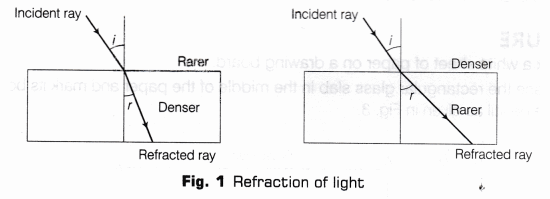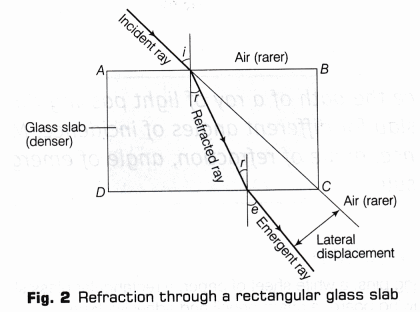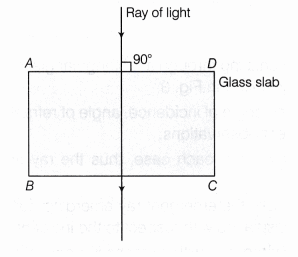CBSE Class 10 Science Lab Manual – Refraction Through Glass Slab
Aim
To trace the path of a ray of light passing through a rectangular glass slab for different angles of incidence. Measure the angle of incidence, angle of refraction, angle of emergence and interpret the result.
Materials Required
Some drawing pins, a white sheet of paper, a rectangular glass slab, a protractor, a measuring scale, a drawing board, a sharp pencil and adhesive tape.
Theory/Principle
Refraction of Light
Change in path of a light ray as it passes from one medium to another medium is called refraction of light. When light travels from a rarer medium to a denser one, it bends towards the normal (i > r) and when travels from a denser medium to a rarer one, it bends away from the normal (i < r) (as shown in Fig. 1).

where, i = angle of incidence and r = angle of refraction
Note: A medium in which the speed of light is more is known as optically rarer medium and the medium in which speed of light is lesser is known as optically denser medium.
Cause of Refraction
Speed of light is different in different media. It is lesser in denser medium and higher in rarer medium. So when light enters a denser medium, its speed reduces and it bends towards the normal and when it enters rarer medium, its speed increases and it bends away from the normal.
Refraction through a Rectangular Glass Slab
When a light ray enters in a glass slab, then the emergent ray is parallel to the incident ray but it is shifted sideward slightly. In this case, refraction takes place twice; first when ray enters glass slab from air and second when exits from glass slab to air.
Both refractions have been shown in Fig. 2 (here glass slab is denser medium and air is rarer medium). The extent of bending of the ray of light at opposite parallel faces AB and CD of rectangular glass slab is equal and opposite. So, the ray emerging from face CD is parallel to incident ray but shifted sideward slightly.

Here, i = angle of incidence, r = angle of refraction and e = angle of emergence
Lateral Displacement
The perpendicular distance between the emergent ray and incident ray when the light passes out of a glass slab is called lateral displacement.
Note: Angle of incidence = angle of emergence, i.e. ∠i = ∠e
if the incident ray falls normally to the surface of glass slab, then there is no bending of the ray of light, it goes straight without any deviation.
Procedure
- Fix a white sheet of paper on a drawing board.
- Place the rectangular glass slab in the middle of the paper and mark its boundary ABCD with the pencil as given in Fig. 3.

- Remove the rectangular glass slab. Draw a thin line XO directing towards O and inclined to the face AD of the glass slab at any angle preferably between 30° and 60°. It is advisable to take point 0 in the middle of the face AD. Replace the glass slab exactly over the boundary marked on the paper.
- Fix two pins P1 and P2 vertically about 5 cm apart by gently pressing their heads with thumb on the line XO.
- Observe the images of pins P1 and P2 through the face BC of the rectangular glass slab. While observing the images of the pins P1 and P2 through the face BC of the glass slab, fix two more pins at points P3 and P4 such that feet of all the pins appear to be in a straight line. In other words, the pins P3 and P4 are collinear with the images of pins P1 and P2.
- Remove the pins and the glass slab and mark the positions of the feet of all the four pins. Join points that mark the positions of the pins P3 and P4 and extend the line upto point O’ where it meets the face BC. Also, join the points O and O’ as given in the Fig. 3, where XOO’Y show the path of a ray of light passing through the glass slab. The line XP1P2O represents the incident ray. Line OO’ shows the path of refracted ray in glass slab while line O’P3P4Y shows the emergent ray.
- Draw the normal NOM to the face AD at the point of incidence O and similarly, the normal M’O’N’, to the face BC at point O’. Measure the angle of incidence XON (∠i), angle of refraction MOO’ (∠r) and angle of emergence M’O’Y (∠e).
- Record the values of ∠i, ∠r and ∠e in the observation table.
- Repeat the experiment for two more angles of incidence in the range 30° to 60° and record the values of angles r and e in each case.
Observations and Calculations
| S.No. | Angle of incidence (∠i ) | Angle of refraction (∠r) | Angle of emergence(∠e) |
| 1. | |||
| 2. | |||
| 3. |
And we know that,
Angle of deviation (∠δ) = Angle of incidence – Angle of emergence
For observation 1, ∠δ1 = ∠i1 – ∠e1 = ………….
For observation 2, ∠δ2 = ∠i2 – ∠e2 = ………..
For observation 3, ∠δ3 = ∠i3 – ∠e3 = ……………..
Result
- The path of a ray of light passing through a rectangular glass slab is traced on the plane sheet and is shown by the ray XOO’Y in Fig. 3.
- The relations between the angle of incidence, angle of refraction and angle of emergence are obtained through different observations.
- From observations, ∠r < ∠i in each case, thus the ray entering from air to glass bends towards the normal.
- From observation, ∠i = ∠e, the emergent ray emerging out of the rectangular glass slab, is parallel to, but laterally displaced with respect to the incident ray.
- Angle of refraction (∠r) increases with increase in angle of incidence (∠i).
Precautions
- The glass slab should be perfectly rectangular with all its faces smooth.
- The tips of pins P1, P2, P3 and P4 should be sharp. These pins fixed on the sheet of paper may not be exactly perpendicular to the plane of paper. Thus, if their heads appear to be collinear, their feet may not be so, Therefore, it must be important to look at the feet of pins and their images while ascertaining collinearity between them. The mark of the pointed end or the foot of a pin on the paper must be considered while marking its position.
- The distance of 5cm between the pins P1 and P2 or P3 and P4 must be carefully maintained to obtain an accurate direction of incident ray and that of emergent ray.
- Take the angle of incidence preferably between 30° and 60°.
- Thin lines should be drawn using a sharp pencil to obtain accuracy.
- The angles should be measured accurately using a good quality protractor having clear markings by keeping the eye above the marking.
Sources of Error
- Drawing board may be hard.
- Drawing pins may not be fixed perpendicularly.
- Eyes may not be kept along the plane of paper in line, while observing the images.
Viva-Voce
Question 1.
Why are the incident and emergent rays parallel to each other, in case of refraction though a rectangular glass slab? [NCERT]
Answer:
As the angle of incidence (∠i) is equal to the angle of emergence (∠e) in case of glass slab, so incident ray is parallel to emergent ray.
Question 2.
Why does a ray of light bend towards the normal, when it enters from air into glass slab and bends away from the normal, when it emerges out into air? [NCERT]
Answer:
It bends towards the normal, when it travels from rarer to denser medium or speed of light decreases in denser medium and vice-versa.
Question 3.
Draw the path of a ray of light, when it enters perpendicular to the surface of a glass slab. [NCERT]
Answer:

Question 4.
While tracing the path of ray of light through a glass slab, the angle of incidence is generally taken between 30° and 60°. Explain the reason on the basis of your performing this experiment for different angles of incidence. [NCERT]
Answer:
These are following reasons:
- If the angle of incidence is less than 30°, bending of light at glass-air interface will be very less.
- If the angle of incidence is greater than 60°, then emergent ray may emerge from the side surface as angle of emergence also increases with the increase in angle of incidence or vice-versa.
Question 5.
How does the lateral displacement of the emergent ray depend on the width of the glass slab and angle of incidence? [NCERT]
Answer:
Lateral displacement is directly proportional to the width or thickness of the glass slab. It is also directly proportional to the angle of incidence.
Question 6.
Give the relation between angle of incidence (∠i), angle of refraction (∠r), angle of emergence (∠e), in this experiment.
Answer:
In this experiment, the relations between ∠i, ∠r and ∠e are ∠e = ∠i and ∠r < ∠i
Question 7.
What happens to the refraction angle, when angle of incidence decreases?
Answer:
On decreasing angle of incidence, angle of refraction also decreases.
Question 8.
What distance should be maintained between the pins P1 and P2 or P3 and P4 to obtain the accurate result?
Answer:
The distance between the pins should be maintained at 5cm, to obtain the accurate result.
Question 9.
Why is it necessary to observe the feet of the pins for collinearity of the points in this experiment?
Answer:
The pins fixed on the sheet of paper may not be exactly perpendicular to the plane of paper. Thus, if their heads appear to be collinear, their feet may not be. So, it is important to observe the collinearity by looking at the feet.
Question 10.
Define an angle of emergence.
Answer:
The angle made by the emergent ray with the normal to the glass-air interface is called an angle of emergence. It is denoted by ∠e.
Question 11.
State some precautions that one should take while performing the experiment on tracing the path of a ray of light passing through a rectangular glass slab for different values of angle of incidence.
Answer:
- Pins should be fixed exactly vertically.
- Angles should be fixed between 30° and 60°.
- Glass slab should be placed well within the outline marked.
Question 12.
When a ray of light refracts through glass slab with parallel surfaces, what is the difference between angle of incidence and angle of emergence?
Answer:
When a ray of light refracts through glass slab with parallel surfaces, then the difference between angle of incidence and angle of emergence is zero.
Science Lab ManualScience Practical SkillsScience LabsMath LabsMath Labs with Activity